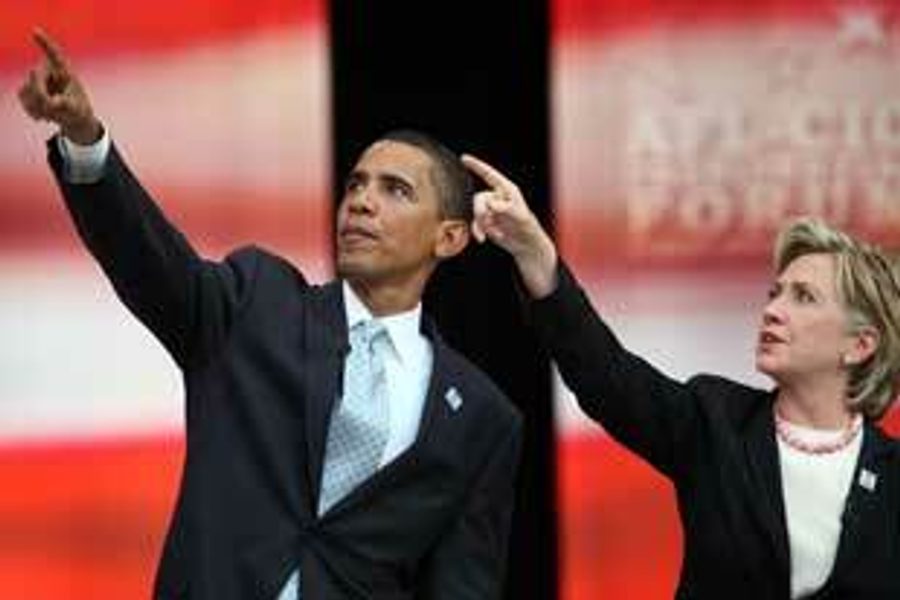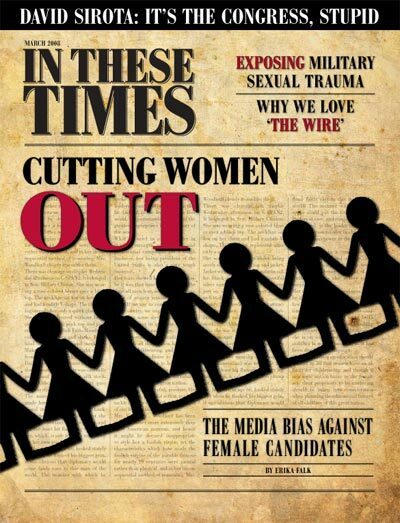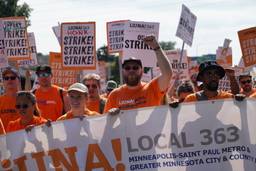
Always a major force in Democratic politics, the labor movement is playing a peculiar role in this year’s presidential primary.
Although the candidates have been more openly pro-union than at any time in the past several decades, labor unions only marginally affected the outcome in the early contests. But they have deeply, if sometimes indirectly, influenced the overall political agenda. And labor’s hope for legislative victories now lies as much with its fledgling parallel campaign to build a popular movement to push for its goals as it does with any particular candidate.
As the candidate of “change” and opposition to the war in Iraq, Sen. Barack Obama (D-Ill.) clearly gained both significant victories and momentum from Super Tuesday balloting. Yet despite his strong support for unions in Illinois, only a few unions nationally have supported him. That leaves organized labor largely outside the growing movement around Obama’s candidacy – a popular movement that labor will need to accomplish its goals.
But most of the reasons that unions didn’t initially coalesce around Sen. Hillary Clinton (D-N.Y.) still hold them back: Their members are divided, and some union leaders are unenthused about her candidacy. Yet according to exit polls, union members – as well as voters with less education, lower incomes and more economic anxiety – favored Clinton in most Super Tuesday states. Obama beat Clinton among young, well-educated, financially secure and independent voters.
The strategic choice for unions remains difficult, much as it has since the beginning of this long campaign.
Take the case of Nevada, where unions were supposed to be a major influence. When John Edwards finished second in Iowa, he hoped that the Las Vegas Culinary Workers, the politically influential UNITE HERE local union of casino workers, would resurrect his presidential campaign. But Edwards, whose campaign had aggressively championed unions, failed to get the Culinary Workers’ endorsement and ended up with only 4 percent of Nevada caucus votes. That led to a weak showing in South Carolina, forcing Edwards to drop out altogether.
Edwards’ ties to UNITE HERE ran deep. In 2004, UNITE – the pre-merger garment worker half of the union – was the only union to endorse Edwards’ first presidential bid. Then in 2006, Edwards joined with HERE – the hotel wing of the union – to travel around the country, promoting new organizing and supporting a nationwide contract campaign. The experience deepened his conviction that, as he said then, “the best anti-poverty program is a union.”
Early last year, a UNITE HERE endorsement of Edwards seemed certain. Nearly the entire executive board of the union supported Edwards, and the Midwest Joint Board was allowed to work for Edwards in Iowa. But the 60,000-member Culinary Workers, which is UNITE HERE’s biggest local, faced tough contract talks and wanted to recruit all of the Democratic candidates to join its fight. As the campaigns unfolded over 2007, the Culinary Workers began talking about the failings of the Edwards campaign in Nevada and about Clinton’s popularity.
As a gambling town, Las Vegas looks down on losers. But one disappointed Edwards supporter in UNITE HERE argued, “Any union should have been behind Edwards, even if he was negative 2 percent in the polls. His whole political persona comes out of interaction with UNITE HERE. In some ways, he has made the most extraordinary run – from a labor perspective – in decades. Why would a politician ever do anything for this union again?”
After his win in the Iowa caucuses, a few UNITE HERE leaders pushed for Obama, but it wasn’t until the evening of the New Hampshire primary a few days later that they all agreed to endorse him. They all still thought highly of Edwards, but as Chicago-based UNITE HERE Vice President Henry Tamarin – the union’s sole Obama backer from the beginning – says, “The good arguments for John Edwards were trumped by the argument that what the labor movement has to figure out is how to win. A good candidate who can win trumps an ideal candidate.”
Clinton, who few UNITE HERE leaders supported, runs a greater risk of losing in the fall and, according to Tamarin, “has no ideological bearings or vision, while Obama does.”
But with the late endorsement, the Culinary Workers couldn’t help Obama overcome Clinton’s popularity in Nevada, especially among Latinos, who make up 40 percent of the union’s members. Meanwhile, its reluctance to embrace Edwards early had deeply hurt his attempt to rally other labor movement leaders and members to his side. Some labor strategists also speculate that, much as they agreed with Edwards’ combative challenge to corporate power, many workers are uncomfortable with the prospect of open conflict or don’t want to see themselves as victims.
The deep divisions within the labor movement – and within each individual union – kept many influential unions from making national endorsements.
Still, Clinton garnered the most support, including unions such as AFSCME (public employees), the Teachers, the Machinists and several building trades. Unions such as the Steelworkers, Mineworkers, Carpenters, Transport Workers and many important state councils from the Service Employees (which made no national endorsement) had initially backed Edwards. Until UNITE HERE joined his camp, Obama had received backing from only the Plumbers and some state councils of the Service Employees and AFSCME.
Yet even unions that endorsed remained divided: a group of AFSCME leaders, for example, sharply criticized AFSCME-financed ads attacking Obama in Iowa (especially because the ads criticized him for opposing individual healthcare mandates, which AFSCME also officially opposes).
“If we could have coalesced, we could have hand-delivered any candidate,” argues Chuck Rocha, Steelworkers political director.
But such unity was impossible and seems unlikely even now, as some Edwards supporters, including the Transport Workers and several Service Employee state councils, switched to Obama.
And many union leaders are angry that former President Bill Clinton charged – without any evidence – that Culinary Workers officials were threatening members if they didn’t vote for Obama, giving anti-union conservatives a convenient club to use against labor’s key proposal for labor law reform.
But for many union members, “the biggest thing that helps Hillary is George W. Bush,” says AFSCME Illinois Director Henry Bayer, an Obama supporter. “By comparison, the Clinton years look like salad days, but if you go back and analyze the record, not much was done for working people.”
All the leading candidates this season have talked about enacting healthcare reform, protecting the middle class, reassessing trade policies, challenging corporations, reversing the rise of inequality and helping unions organize more freely. Edwards and, to a lesser extent, former presidential candidate Rep. Dennis Kucinich (D-Ohio) pushed the candidates toward labor’s more economic populist positions.
“It’s undeniable that the labor movement has in large part framed the debate for the election in 2008 and will continue to do so,” says AFL-CIO Organizing Director Stewart Acuff.
The AFL-CIO has already launched a campaign for healthcare reform, as well as member education campaigns on the economy, organizing rights and trade. It has also endorsed the Communications Workers’ proposal to build an army of politically active union stewards.
Like the AFL-CIO campaign, the Service Employees’ five-year-old campaign for healthcare reform focuses on several broad principles.
But the labor movement remains divided over whether to push for single-payer, Medicare-for-all plan or attempt to strengthen some less satisfactory plan, such as those proposed by both Obama and Clinton.
The California Nurses Association, for example, is running an aggressive public campaign for a single-payer plan, which 32 state labor federations and 14 international unions have endorsed in principle. And after California failed to enact a complex, compromise insurance plan based on mandating individuals to buy insurance, Sal Rosselli, president of the Service Employees’ giant West Coast healthcare local, concluded, “We need to coalesce all progressive organizations and come up with a national strategy that’s more like Medicare-for-all.”
Important as the election will be, the labor movement is likely to win its goals only if it can turn that political energy into an effective, lasting force with progressive allies.
“You’re not going to bring change in this country through the presidents of the 12 biggest unions or through the Democratic Party, which is too tied up with the corporations,” argues Roger Tauss, Transport Workers political director. “The model is 1932, when FDR didn’t run as a progressive, and social movements pushed him to do the right thing.”
The model may be right, but the movement has yet to be created.
David Moberg, a former senior editor of In These Times, was on staff with the magazine from when it began publishing in 1976 until his passing in July 2022. Before joining In These Times, he completed his work for a Ph.D. in anthropology at the University of Chicago and worked for Newsweek. He received fellowships from the John D. and Catherine T. MacArthur Foundation and the Nation Institute for research on the new global economy.









